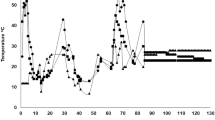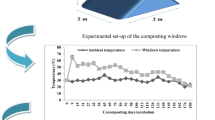Abstract
Co-composting of the solid residues and wastewater from the olive oil production process was examined as a potential bioremediation treatment for these wastes. Experimental results from a semi batch laboratory pilot plant were reported. Composting was performed for 20 days under constant moisture 40% and the temperature ranged from 55 to 72°C and the oxygen partial pressure from 10 to 17%. An operational region of temperature and oxygen partial pressure was defined in order to achieve a ratio of total olive mill wastewater consumption to olive stone wooden residue stabilization equal or greater than 2.5, the typical ratio for an olive mill plant. Another critical parameter for the optimisation of the 20-day co-composting process that was examined was the biological efficiency of the process, as the carbon dioxide produced to the total carbon available to biomass. A strong sigmoid correlation of co-composting efficiency with temperature derived, reaching a maximum plateau of 0.50 at 68°C. The optimum conditions for a 20-day semi batch co-composting proved to be 68°C and 16–17% oxygen partial pressure, indicating that this process could be an integrated treatment scheme for olive mills.







Similar content being viewed by others
References
APHA (1985) Standard method for the examination of water and wastewater, 16th edn. American Public Health Association, Washington
Azbar N, Bayram A, Filibeli A, Muezzinoglu A, Sengul F, Ozer A (2004) A review of waste management options in olive oil production. Crit Rev Environ Sci Technol 34:209–247
Cronjé A, Turner C, Williams A, Barker A, Guy S (2003) Composting under controlled conditions. Environ Technol 24(10):1221–1234
Di Serio MG, Lanza B, Mucciarella MR, Russi F, Iannucci E, Marfisi P, Madeo A (2008) Effects of olive mill wastewater spreading on the physico-chemical and microbiological characteristics of soil. Int Biodeter Biodegr 62(4):403–407
Gomes AP, Pereira AF (2008) Mathematical modelling of a composting process, and validation with experimental data. Waste Manag Res 26(3):276–287
Hachicha S, Sallemi F, Medhioub K, Hachicha R, Ammar E (2008) Quality assessment of composts prepared with olive mill wastewater and agricultural wastes. Waste Manag 28:2593–2603
Haug TR (1980) Compost engineering: principles and practice. Technomic Publishing Co, Inc., Lancaster
Jarboui R, Sellami F, Kharroubi A, Gharsallah N, Ammar E (2008) Olive mill wastewater stabilization in open-air ponds: impact on clay-sandy soil. Bioresour Technol 99(16):7699–7708
Kaiser J (1996) Modelling composting as a microbial ecosystem: a simulation approach. Ecol Model 91(1–3):25–37
Liang C, Das KC, McClendon RW (2003) The influence of temperature and moisture contents regimes on the aerobic microbial activity of a biosolids composting blend. Bioresour Technol 86(2):131–137
Mason IG, Milke MW (2005) Physical modelling of the composting environment: a review. Part 1: reactor systems. Waste Manag 25(5):481–500
Niaounakis M, Halvadakis CP (2004) Olive-mill waste management: literature review and patent survey. Typothito George Dardanos Publications, Athens
Paraskeva P, Diamadopoulos E (2006) Technologies for olive mill wastewater (OMW) treatment: a review. J Chem Technol Biotechnol 81(9):1475–1485
Petric I, Selimbašić V (2008) Development and validation of mathematical model for aerobic composting process. Chem Eng J 139(2):304–317
Richard TL, Walker LP, Gossett JM (2006) Effects of oxygen on aerobic solid-state biodegradation kinetics. Biotechnol Progress 22(1):60–69
Taralas G, Kontominas M (2006) Pyrolysis of solid residues commencing from the olive oil food industry for potential hydrogen production. J Anal Appl Pyrol 76(1–2):109–116
Vlyssides AG, Bouranis DL, Loizidou M, Karvouni G (1996) Study of a demonstration plant for the co-composting of olive-oil-processing wastewater and solid residue. Bioresour Technol 56(2–3):187–193
Vlyssides AG, Loizidou M, Zorpas AA (1999) Characteristics of solid residues from olive oil processing as bulking material for co-composting with industrial wastewaters. J Environ Sci Health A 34(3):737–748
Vlyssides A, Barampouti EM, Mai S (2008) Physical characteristics of olive stone wooden residues: possible bulking material for composting process. Biodegradation 19(2):209–214
Vlyssides A, Barampouti EM, Mai S (2009) An integrated mathematical model for co-composting of agricultural solid wastes with industrial wastewater. Bioresour Technol 100(20):4797–4806
Wang W-D, Wang X-F, Liu J-B, Gao L-J, Li X-M, Cui Z-J (2006) Effect of oxygen concentrations on process of composting. Huanjing Kexue/Environ Sci 27(3):594–598
Author information
Authors and Affiliations
Corresponding author
Rights and permissions
About this article
Cite this article
Vlyssides, Α., Barampouti, E.M., Mai, S. et al. Effect of temperature and aeration rate on co-composting of olive mill wastewater with olive stone wooden residues. Biodegradation 21, 957–965 (2010). https://doi.org/10.1007/s10532-010-9355-y
Received:
Accepted:
Published:
Issue Date:
DOI: https://doi.org/10.1007/s10532-010-9355-y




